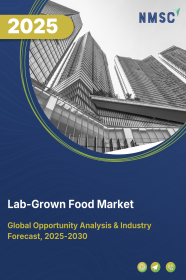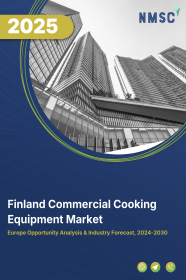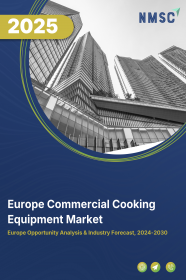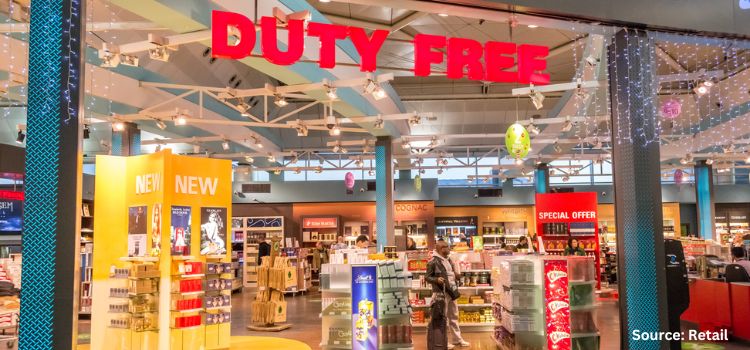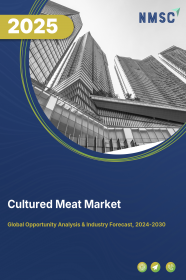
Cultured Meat Market by Source (Poultry, Beef, Pork, and Sea Food), by Production Technique (Scaffold-Based Technique, Self-Organizing Technique, and Cell Culture Media), by Technologies (Growth Medium, Bioreactors, Scaffolds, Starter Cells, and Others), by Distribution Channel (Hypermarkets, Convenience Stores, Online Retail Stores, Food & Drink Specialty Stores, and Others), and Others -Global Opportunity Analysis and Industry Forecast 2022-2030
US Tariff Impact on Cultured Meat Market
Trump Tariffs Are Reshaping Global Business
Market Definition:
The Cultured Meat Market size was valued at USD 2.3 million 2021 and is estimated to reach USD 960.7 million by 2030 with a CAGR of 80.7% from 2022-2030. Cultured meat is also known as in-vitro meat, lab-grown meat, or synthetic meat and it’s produced by various practices of tissue engineering methods and cellular agriculture.
It involves the production of edible biomass by in-vitro culture of stem cells harvested from the muscle of live animals by self-organizing or scaffolding methodology. The manufacturing process begins when stem cells are acquired and stored from an animal.
These cells are then grown in bioreactors or cultivators at high density and volume. Similar to what happens inside an animal’s body, the cells are fed an oxygen-rich cell culture medium that is made up of basic nutrients such as amino acids, glucose, vitamins, and inorganic salts and supplemented with proteins and other growth factors.
Synthetic meat is used as an alternative protein product that includes minerals, fats, and amino acids. Lab-grown meat is associated with several benefits such as reducing the risk to public health and eliminating the need to raise animals.
Market Dynamics and Trends:
The increase in demand for lab-grown meat is due to the growing concerns about environmental awareness and animal welfare that supports the consumption of animal cruelty-free products. For instance, in December 2020, Eat Just received its regulatory approval in Singapore for its GOOD Meat synthetic meat product which is a fusion of cultured chicken cells and plant proteins without compromising animal lives. It was a major step for the cultured meat industry that could speed up the approval process in huge markets, such as the United States, China, and European Union.
Also, the popularity of meat consumption among people across the world increases stress on traditional meat sources, which could be reduced by the commercial production of cultured meat. This is expected to penetrate the growth of the cultured meat market worldwide. For instance, according to the estimation of US Food and Agricultural Policy Research Institute in 2020, the average per capita meat consumption per person in the world was 38.7 kilograms.
Moreover, the cultured meat is less contaminated and manufactured in hygienic standards, and thus it is consumed as a healthy alternative to conventional meat. Furthermore, many consumers are shifting their focus toward complying with a higher nutritional diet that aims for better sustainable life and reduced dependency on animal products, which in turn encourages the growth of the cultured meat market globally.
On the other hand, increase in production cost along with lack of awareness about the benefits of synthetic meat, are factors expected to restrain the growth of cultured meat market during the forecast period. On the contrary, technological advancements in tissue engineering such as edible scaffolds & 3D bioprinting, and a significant rise in investments in research & development projects such as CULTURED MEAT are expected to create ample opportunities for the cultured meat market during the forecast period.
Market Segmentations and Scope of the Study:
The cultured meat market is segmented on the basis of source, production technology, distribution channel, application, and geography. On the basis of source, the market is classified into poultry, pork, beef, and seafood. Based on production technique, the market is divided into scaffold-based technique, self-organizing technique, and cell culture media. On the basis of technology, the market is bifurcated into growth medium, bioreactors, scaffolds, and starter cells. On the basis of distribution channel, the market is segmented into hypermarkets, convenience stores, online retail stores, food and drink specialty stores, and others. On the basis of application, the market is categorized into hot dogs, nuggets, burgers, meatballs, sausages, and others. The geographical breakdown and analysis of each of the aforesaid segments include regions comprising of North America, Europe, Asia Pacific, and RoW.
Geographical Analysis:
North America holds the lion share in the global cultured meat market and is expected to remain dominant throughout the forecast period. This is attributed to the factors such as rise in innovations and advancements in the lab-grown meat industries along with high spending for efficient R&D.
For instance, in May 2022, Eat Just, the US sustainable food start-up signed agreement with ABEC Inc. an equipment manufacturer to build massive bioreactors to increase meat production. The company is planning to install 10 bioreactors in the United States to begin production in 2025, with the goal of generating 30 million pounds of chicken and beef annually.
Also, the increasing demand for alternative protein due to consumers’ health awareness concerns as well as the openness & acceptance of meat substitutes and alternative proteins among the consumers are driving the market growth in this region.
On the other hand, Europe is expected to witness a steady rise in the cultured meat market due to the shifting preferences towards meat substitutes that has eventually led wealthy investors pilling into the cultured meat market. For instance, in October 2020, Meat4All, a cultured meat research program led by a Spanish biotech firm has been awarded a USD 2.69 million grant under the European Union’s Horizon 2020, R&D funding framework.
It was the first lab-grown meat research effort to get public investment by the EU. Also, European consumers are highly conscious of the environmental harm triggered by meat production and are concerned about animal safety, which encourages them to adopt synthetic meat products. Moreover, higher growth opportunities in this market are encouraging market players such as Higher Steaks and Nomad Foods to invest in alternative meat protein like cultured meat to exhilarate the ever-rising consumer demand for sausage and bacon.
Competitive Landscape:
The cultured meat market includes various major market players such as Mosa Meat, UPSIDE Foods, SuperMeat, Aleph Farms, Future Meat Technologies Ltd., Cubiq Foods S.L, Nomad Foods, Integriculture Inc., Meatable, New Age Meats. These key market players adopt various market strategies to sustain their dominance in the cultured meat market across the globe, such as joint ventures, and developmental agreements.
For Instance, in February 2021, Mosa Meat received funds as a part of its Series B funding from investors such as animal nutrition & fish feed group - Nutreco and Jitse Groen- CEO of Just Eat Takeaway.com. The company would use the fundings to expand its team, escalate the industrial size production line and avail cultivated meat in the retail market.
Also, in September 2021, Nomad Foods, a U.K based frozen fish company, joined hands with BlueNalu, a U.S based seafood cultured business on a food project. This project will help to meet the rising demand and support to safeguard the quality, affordable seafood as well as healthy for people and sustainable for the planet.
Key Benefits:
-
The cultured meat market report provides the quantitative analysis of the current market and estimations through 2022-2030 that assists in identifying the prevailing market opportunities to capitalize on.
-
The study comprises a deep dive analysis of the cultured meat market trend including the current and future trends for depicting the prevalent investment pockets in the market.
-
The information related to key drivers, restraints and opportunities and their impact on the cultured meat market is provided in the report.
-
The competitive analysis of the market players along with their market share in the cultured meat market
-
The SWOT analysis and Porters Five Forces model is elaborated in the study.
-
Value chain analysis in the market study provides a clear picture of the stakeholders’ roles.
Key Market Segments:
By Source
-
Poultry
-
Pork
-
Beef
-
Seafood
By Production Technique
-
Scaffold-Based Technique
-
Self-Organizing Technique
-
Cell Culture Media
By Technology
-
Growth Medium
-
Bioreactors
-
Scaffolds
-
Starter Cells
-
Others
By Distribution Channel
-
Hypermarkets
-
Convenience Stores
-
Online Retail Stores
-
Food and Drink Specialty Stores
-
Others
By Application
-
Hot Dogs
-
Nuggets
-
Burgers
-
Meatballs
-
Sausages
-
Others
By Geography
-
North America
-
U.S.
-
Canada
-
Mexico
-
-
Europe
-
UK
-
Germany
-
France
-
Spain
-
Italy
-
Netherlands
-
Denmark
-
Finland
-
Norway
-
Sweden
-
Russia
-
Rest of Europe
-
-
Asia-Pacific
-
China
-
Japan
-
India
-
South Korea
-
Australia
-
Indonesia
-
Singapore
-
Taiwan
-
Thailand
-
Rest of Asia-Pacific
-
-
Rest of World
-
Latin America
-
Middle East
-
Africa
-
Key Players
-
Mosa Meat
-
UPSIDE Foods
-
SuperMeat
-
Aleph Farms
-
Future Meat Technologies Ltd.
-
Cubiq Foods S.L
-
Nomad Foods
-
Integriculture Inc.
-
Meatable
-
New Age Meats
REPORT SCOPE AND SEGMENTATION:
|
Parameters |
Details |
|
Analysis Period |
2021–2030 |
|
Base Year Considered |
2021 |
|
Forecast Period |
2022–2030 |
|
Market Size Estimation |
Million (USD) |
|
Market Segmentation |
By Source (Poultry, Beef, Pork, and Sea Food), by Production Technique (Scaffold-Based Technique, Self-Organizing Technique, and Cell Culture Media), by Technologies (Growth Medium, Bioreactors, Scaffolds, Starter Cells, and Others), by Distribution Channel (Hypermarkets, Convenience Stores, Online Retail Stores, Food & Drink Specialty Stores, and Others), and by Applications (Hot Dogs, Nuggets, Burgers, Meatballs, Sausages, and Others) |
|
Countries Covered |
28 |
|
Companies Profiled |
Mosa Meat, UPSIDE Foods, SuperMeat, Future Meat Technologies Ltd., Cubiq Foods S.L, Nomad Foods, Integriculture Inc., Eat Just Inc., New Age Meats, Aleph Farms, Higher Streaks, Appleton Meats, Meatable, and BlueNalu. |

















 Speak to Our Analyst
Speak to Our Analyst



